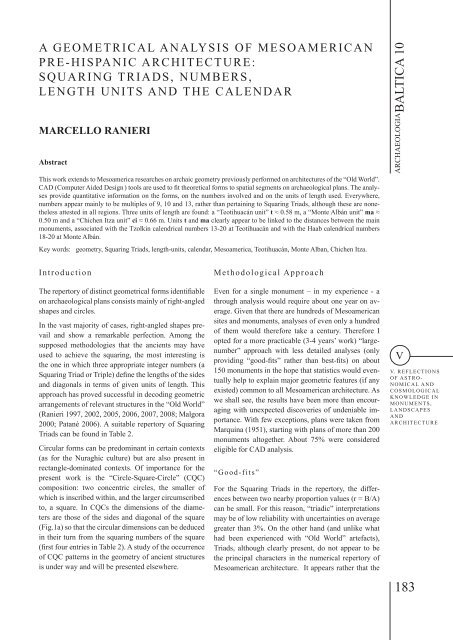BALTICA10
BALTICA10
BALTICA10
You also want an ePaper? Increase the reach of your titles
YUMPU automatically turns print PDFs into web optimized ePapers that Google loves.
A GEOMETRICAL ANALYSIS OF MESOAMERICAN<br />
PRE-HISPANIC ARCHITECTURE:<br />
SQUARING TRIADS, NUMBERS,<br />
LENGTH UNITS AND THE CALENDAR<br />
MARCELLO RANIERI<br />
Abstract<br />
This work extends to Mesoamerica researches on archaic geometry previously performed on architectures of the “Old World”.<br />
CAD (Computer Aided Design ) tools are used to fit theoretical forms to spatial segments on archaeological plans. The analyses<br />
provide quantitative information on the forms, on the numbers involved and on the units of length used. Everywhere,<br />
numbers appear mainly to be multiples of 9, 10 and 13, rather than pertaining to Squaring Triads, although these are nonetheless<br />
attested in all regions. Three units of length are found: a “Teotihuacán unit” t ≈ 0.58 m, a “Monte Albán unit” ma ≈<br />
0.50 m and a “Chichen Itza unit” ci ≈ 0.66 m. Units t and ma clearly appear to be linked to the distances between the main<br />
monuments, associated with the Tzolkin calendrical numbers 13-20 at Teotihuacán and with the Haab calendrical numbers<br />
18-20 at Monte Albán.<br />
Key words: geometry, Squaring Triads, length-units, calendar, Mesoamerica, Teotihuacán, Monte Alban, Chichen Itza.<br />
ARCHAEOLOGIA BALTICA 10<br />
Introduction<br />
The repertory of distinct geometrical forms identifiable<br />
on archaeological plans consists mainly of right-angled<br />
shapes and circles.<br />
In the vast majority of cases, right-angled shapes prevail<br />
and show a remarkable perfection. Among the<br />
supposed methodologies that the ancients may have<br />
used to achieve the squaring, the most interesting is<br />
the one in which three appropriate integer numbers (a<br />
Squaring Triad or Triple) define the lengths of the sides<br />
and diagonals in terms of given units of length. This<br />
approach has proved successful in decoding geometric<br />
arrangements of relevant structures in the “Old World”<br />
(Ranieri 1997, 2002, 2005, 2006, 2007, 2008; Malgora<br />
2000; Patanè 2006). A suitable repertory of Squaring<br />
Triads can be found in Table 2.<br />
Circular forms can be predominant in certain contexts<br />
(as for the Nuraghic culture) but are also present in<br />
rectangle-dominated contexts. Of importance for the<br />
present work is the “Circle-Square-Circle” (CQC)<br />
composition: two concentric circles, the smaller of<br />
which is inscribed within, and the larger circumscribed<br />
to, a square. In CQCs the dimensions of the diameters<br />
are those of the sides and diagonal of the square<br />
(Fig.1a) so that the circular dimensions can be deduced<br />
in their turn from the squaring numbers of the square<br />
(first four entries in Table 2). A study of the occurrence<br />
of CQC patterns in the geometry of ancient structures<br />
is under way and will be presented elsewhere.<br />
Methodological Approach<br />
Even for a single monument – in my experience - a<br />
through analysis would require about one year on average.<br />
Given that there are hundreds of Mesoamerican<br />
sites and monuments, analyses of even only a hundred<br />
of them would therefore take a century. Therefore I<br />
opted for a more practicable (3-4 years’ work) “largenumber”<br />
approach with less detailed analyses (only<br />
providing “good-fits” rather than best-fits) on about<br />
150 monuments in the hope that statistics would eventually<br />
help to explain major geometric features (if any<br />
existed) common to all Mesoamerican architecture. As<br />
we shall see, the results have been more than encouraging<br />
with unexpected discoveries of undeniable importance.<br />
With few exceptions, plans were taken from<br />
Marquina (1951), starting with plans of more than 200<br />
monuments altogether. About 75% were considered<br />
eligible for CAD analysis.<br />
“Good-fits”<br />
For the Squaring Triads in the repertory, the differences<br />
between two nearby proportion values (r = B/A)<br />
can be small. For this reason, “triadic” interpretations<br />
may be of low reliability with uncertainties on average<br />
greater than 3%. On the other hand (and unlike what<br />
had been experienced with “Old World” artefacts),<br />
Triads, although clearly present, do not appear to be<br />
the principal characters in the numerical repertory of<br />
Mesoamerican architecture. It appears rather that the<br />
V<br />
V. REFLECTIONS<br />
OF ASTRO-<br />
NOMICAL AND<br />
COSMOLOGICAL<br />
KNOWLEDGE IN<br />
MONUMENTS,<br />
LANDSCAPES<br />
AND<br />
ARCHITECTURE<br />
183
















